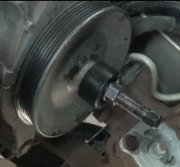Good morning and thank you for visiting 2CarPros.
There is no rule that says that a power steering pump needs to make noise when it fails. I have personally seen pumps that fail to produce enough pressure to function properly without the whining noise most people are used to hearing.
It could be that your pump is doing the same, putting out lower than normal pressure which makes you have to rev up the engine to get enough pressure to move the piston in the steering rack. I am also making an assumption here that the serpentine belt is in good shape and not squealing since you said there weren't any noises!
From what it sounds like to me and taking into consideration that you already replaced the rack and checked the lines for clogs it is my suspicion that the pump itself is failing. A replacement pump will cost about $40.00 to $150.00 depending if you buy an aftermarket or re-manufactured brand or a genuine AC Delco brand.
To Replace the power steering pump:
1. Remove the radiator intake baffle (see diagrams).
2. Remove the air cleaner housing assembly.
3. Remove the serpentine belt.
4. Place a pan under the power steering pump to catch the fluid when you open up the system.
5. Disconnect the high pressure hose.
6. Disconnect the hose coming from the oil cooler.
7. Un-clip the wire harness from the loom located on the pump housing.
8. Remove the mounting bolts from the power steering pump
9. Remove the pump.
10. Remove the Pulley from the old pump. (You will need special tools for the pulley, J 25033-C power steering pump pulley installer, and a J 25034-C pulley remover.)
Assemble in the reverse order.
After completion, bleed the system. This is a very important step as any trapped air can cause cavitation and could damage your pump over time.
To bleed the system you will need a vacuum pump and an adapter to attach the pump the to power steering fluid reservoir filler neck.
1. Remove the filler cap.
2. Fill the pump reservoir to the "Full Cold" level.
3. Attach the vacuum pump to the reservoir (see attached picture)
4. Apply a vacuum to the reservoir (about 20 in-hg)
5. Wait five minutes (check vacuum level - a loss of 1-2 in hg is normal)
6. Remove the vacuum pump.
7. Reinstall the cap
8. Start the engine and allow to idle for a few minutes
9. Shut off the engine
10. Check the fluid level. Add fluid as needed and repeat steps 8-10 until fluid level is stable.
11. Start the engine again and allow it to idle.
12. From the steering wheel centered position, turn the steering wheel to the left 1 full turn, then back to center, then to the right 1 full turn. Repeat this 5 times
13. Turn off the engine
14. Repeat steps 2 - 10
Hope that helps
Jon
Images (Click to make bigger)
Thursday, May 30th, 2019 AT 5:45 AM









